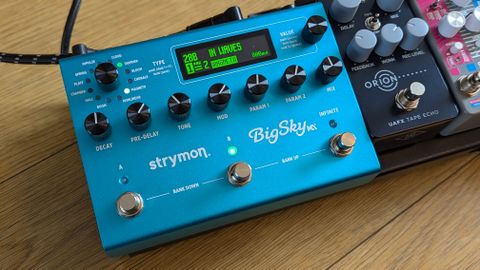MusicRadar Verdict
MusicRadar verdict: The biggest challenge the MX faces is just how well the original BigSky stills stand up all these years later. Some of the extra features here will be excess for some but undoubtedly enhance widen the horizons of one of the greatest reverb pedals ever.
Pros
- +
Refreshed algorithms and two new modes.
- +
Ensemble feature on Cloudburst is welcome.
- +
IR loader and dual reverbs are great for experimenting.
Cons
- -
The new features may have more niche appeal for some.
MusicRadar's got your back
Strymon BigSky MX Multi Reverb: What is it?
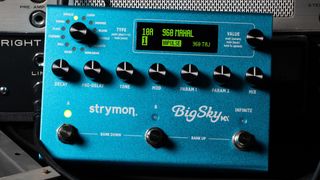
When you’ve made one of the very best reverb pedals that’s managed to stay in the top tier for over a decade, what do you do?
For starters, a more powerful processor here has facilitated Strymon to completely rework five of the BigSky’s cornerstone 'machines' (Spring, Plate, Hall, Room & Shimmer), while also including the original versions too – just to get ahead of anyone who demands to get nostalgic. Obviously, this allows you and I to A/B sounds without the original too. But we don’t have to choose between pedals to do it.
Of course, that isn’t enough to justify the price increase so there’s more; true stereo, two completely new algorithms are now onboard with Impulse and Chamber, bringing the total reverb modes to 12, each with the usual deep editing via the pedal's parameter controls.
The added tri-core 800 MHz ARM processing power (in place of SHARC) now allows players to run two of these algorithms at the same time that pushes the BigSky’s already huge potential far wider for the tinkerers and sonic explorers amongst us. The MX is also a reverb IR loader for the Impluse mode with 22 already onboard, and the option to upload third-party IRs.
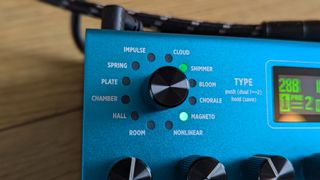
There’s a dedicated Infinite footswitch that the likes of Walrus Audio have put to great use on some of their ambient reverbs since the BigSky surfaced, a larger OLED screen with variable brightness and a high contrast that’s great for viewing onstage (surprisingly our test unit has a blemish spot under the surface). There’s also a USB-C connection that cn integrate editing presets on computer in the future via an update to Strymon’s Nixie 2 software.
We already know the BlueSky offers one of the most glorious and versatile reverb experiences around. The key question is whether the additions are enough to prompt an upgrade for existing users, or added investment for a newcomer. The BigSky casts a huge shadow all these years later, which is pretty remarkable in such a rapidly evolving digital effects market.
Strymon BigSky MX Multi Reverb: Performance and verdict
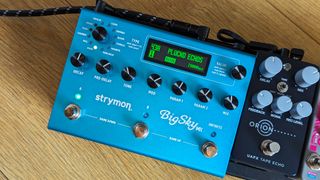
The new Chamber algorithm is really useful; it feels like the space between large room and hall reverbs. I actually really liked it as a solo sound. Impulse allows access to the aforementioned IR sounds the MX ships with onboard or are loaded in by the player.
The new 'handcrafted' versions of the five algorithms may take existing fans a while to get their ears used to – they're brand new. To my ears the new versions sound clearer and brighter in isolation. You’ve got the choice of both if you buy the MX.
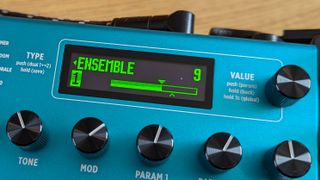
It’s great to see the Cloud algorithm being given an unexpected update on the BigSky MX with the glorious, lush Ensemble strings-style mode we loved on the Cloudburst pedal. For me it sweetens the $679 pricetag vs $479 for the original BigSky because Ensemble is such an inspiring mode that could be really useful for orchestral pad sounds in your recordings, with sensitive scope in how subtle or loud you want it in your signal.
I can’t help feeling dual algorithms on a possible Timeline MX delay will have much wider appeal than on a reverb pedal
The ability to use two different reverbs in series, parallel and panned is really interesting, but relatively niche. It allows these diverse algorithms to be blended with huge new potential for sonic design. Widen your sound in a whole new way by splitting reverbs in the left and right channel without your dry guitar signal getting washed away, or really go deep into the void with combinations. But I can’t help feeling dual algorithms on a possible Timeline MX delay will have much wider appeal than on a reverb pedal.
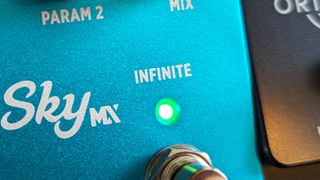
At first, it seems as though the Infinite switch has limitations for those of us who want to use it to create a pad to jam over. Pressing the button means an infinite note, that can be set to latching as soon as the Freeze switch is pressed (and turned off when you press it again), or momentary so it only sustains as long as you’re holding the switch down.
There are three modes for this; Off, Freeze and Infinite. In Freeze you can only play a dry signal along with your loop. Not particularly desirable for jamming. So we try Infinite; You can play along with a wet signal over the infinite part but anything you play will sustain infinitely too; adding to the loop. Again, not really good for those of us who want to jam along to a sustaining pad chord or note. But there is a solution – and that’s where the ability to use duel reverbs proves essential for Freeze mode: the first reverb on switch A to freeze a part to create a pad under your playing, the second reverb preset to switch B to play over it.
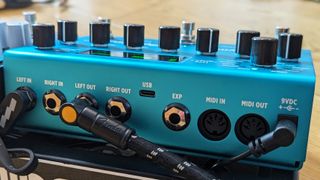
I think the extra outlay here is really for recording and home players and going to town to discover new ways to meld reverb further than the now familiar sounds of the standard BigSky
For live players used to using one reverb algorithm at a time, will anyone really be able to tell onstage when you move up to the new sounds here, or combine them – will you? Most gear acquisition justification questions are about how you feel, not what other people might notice. But aside from stereo rig users, I think the extra outlay here is of most value for recording and home players; those looking to discover new ways to meld reverb further than the now familiar sounds of the standard BigSky. It offers more of Strymon’s algorithms and potential to experiment with the new versions and combining them. Indeed, there's more reverb options here than most of us will know what to do with, but there is something really attractive in that.
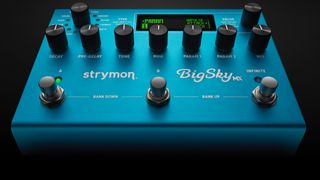
Strymon’s proposition with its BigSky line in 2024 actually ends up being a good problem to have for the customer; because there are options
If you fall into that group the $200 will be less of an obstacle and simply more money for more goodness you’ll spend quality time with. But it takes the already substantial outlay of the BigSky further out of impulse-purchase territory and more towards the Eventide H90 end of the market.
Strymon’s proposition with its BigSky line in 2024 actually ends up being a good problem to have for the customer; because there are options. The original BigSky’s reputation has proven it to be an investment that pays dividends for pros and home-only players alike – plus everyone in between. Frankly, it’s remarkable that a digital pedal is still up there with the best this far into its life, but its sounds remain hugely inspiring and exciting to explore.
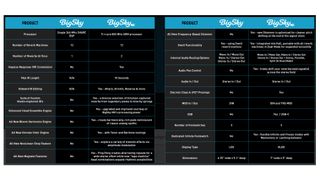
The MX furthers the argument that the original BigSky is still a great purchase in 2024 with more reverb options than most of us would ever want or need. And if you really want more, well it’s here for an extra $200.
MusicRadar verdict: The biggest challenge the MX faces is just how well the original BigSky still stands up all these years later. Some of the extra features here will be excess for some but undoubtedly enhance widen the horizons of one of the greatest reverb pedals ever.
Strymon BigSky MX Multi Reverb: Hands-on videos
Mark Johnston
Antoine Michaud
Strymon
Line 6 HX One: Specifications
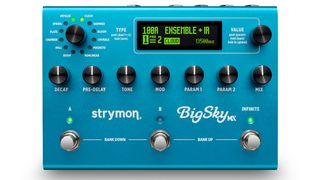
- Controls: Reverb Machine selection rotary knob, Decay, Pre-delay, Tone, Modulation, Parameter 1, Parameter 2, Mix level, Value, A, B and Infinite footswitches
- Features: 300 presets (100 factory), 24-bit, 96 kHz, 116 dB typical Signal/Noise, dual ultra high-performance 800MHz tri-core 32-bit floating ARM processors, stereo input and output, selectable input level for instrument and line level signal, analog dry path, two simultaneous reverbs with series, parallel and split, pan routing, 22 impulses preloaded (10sec IR playback), OLED screen, dedicated Infinite/Freeze footswitch, EXP input to connect optional TRS expression pedal, MultiSwitch, MultiSwitch Plus, or TRS MIDI, USB-C jack for firmware updates, MIDI I/O, and patch upload/download/real-time desktop parameter control/IR loading via Strymon Nixie 2 editor
- Bypass: Choice of Buffered or True
- Power: 9v 2.1mm centre negative 500mA minimum power supply (not included)
- Dimensions: (W x D x H): 12.7 cm wide x 2.7 cm deep x 4.8 cm
- Current Draw: 500mA
- CONTACT: Strymon

I'm the Guitars Editor for MusicRadar, handling news, reviews, features, tuition, advice for the strings side of the site and everything in between. Before MusicRadar I worked on guitar magazines for 15 years, including Editor of Total Guitar in the UK. When I'm not rejigging pedalboards I'm usually thinking about rejigging pedalboards.

“I was considered an ugly woman who took your monument away... some of his closest friends told me that probably I should stay in the background, I should shut up”: New Lennon doc throws light on the prejudice Yoko One faced

Music theory you can use: 6 chord tricks for songwriters and producers

Former Oasis drummer Alan White teases photo of Don’t Look Back in Anger bass drum head ahead of Oasis reunion
